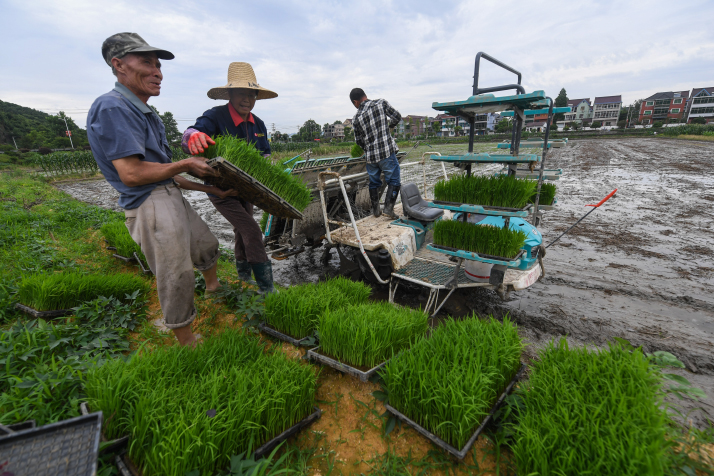Demonstration program launched for China's next grand goal

Visitors taste wine from Hungary at the China-Central and Eastern European Countries Expo in Ningbo, Zhejiang Province, on June 9 (XINHUA)
Steering the population toward a better life and common prosperity is the committed objective of the Communist Party of China (CPC). Chinese leader Deng Xiaoping, the architect of reform and opening up, declared that poverty does not equate to socialism, and the essence of socialism is liberation and development of productivity, elimination of exploitation and polarization, and the ultimate achievement of prosperity for all.
Over the past four decades, China has recorded remarkable achievements in social and economic development, particularly by hitting the goal of eliminating absolute poverty in 2020, paving the way for common prosperity.
However, despite its huge economic aggregate, China now faces large regional disparities in terms of income and development. In this context, achieving common prosperity will only be a time-consuming and daunting task. Thus, it's necessary to select a certain area to serve as a pilot zone, so that its experiences can be imitated by others.
On June 10, the central authorities issued a document to stress its support for the efforts on the part of Zhejiang Province to develop a demonstration zone. This document shows that prosperity for all is no longer a mere blueprint, but from this point onward will take physical shape through tangible efforts.
Zhejiang stands out
A prerequisite for any such demonstration zone is that it must be a bellwether of development in the country.
The top five provincial economies on the Chinese mainland in 2020 were Guangdong, Jiangsu, Shandong, Zhejiang and Henan. So why did these other economic champions not make the cut? As a coastal province in the east, Zhejiang is a pioneer in sustaining economic development and addressing disparities. It boasts multiple advantages in validating common prosperity, yet at the same time has a few weak links of its own to take into account. Consequently, Zhejiang is able to set an example for other provinces.
In 2020, the province's GDP hit 6.46 trillion yuan ($1 trillion), which if it were a country would rank among the world's top 20. Nevertheless, uneven economic growth still exists.
The key is that Zhejiang has begun to explore ways of filling the gaps based on its strong overall economic strength. Now, urban resident incomes are 1.96 times that of rural residents, far below the rural-urban income gap in other provinces.
Then how difficult is the task?
According to the document, by 2025, Zhejiang will bear tangible fruits in its development as a demonstration zone for common prosperity. The province has to continuously narrow the gap between rural and urban areas as well as the gap in living conditions and incomes. It needs to empower low-income groups to earn more, enhance social welfare on the whole and build an olive type of social structure where middle-income earners compose the majority. By 2035, Zhejiang will have basically realized common prosperity, a lofty goal that looms only 15 years into the future.
Common prosperity is a systematic concept that features material and cultural richness, social progress, and harmonious coexistence between humanity and nature. Obviously, to establish such a demonstration zone, the most difficult part does not lie in how to boost economic growth, but in how to coordinate economic development, cultural progress, the enhancement of public services and environmental protection.
The document puts forward six specific measures: (1) enhancing the quality and efficiency of economic development to lay a solid material foundation; (2) deepening reforms on income distribution and increasing sources of income to bridge income gaps; (3) realizing high-quality public services for all to narrow the gaps between urban and rural areas; (4) promoting cultural progress to enrich people's cultural life;
(5) making the environment more suitable for living in; and (6) creating a comfortable social environment to explore a more efficient social management model.
Despite the hardships of creating such a demonstration zone, the experience accumulated during reform and opening up points to final success of this effort. Zhejiang is blessed with a relatively high level of wealth and social development. More importantly, the province is endowed with a strong sense of reform and innovation, providing fertile soil for the task at hand to triumph.


Farmers work in a rice field in rural Hangzhou, Zhejiang Province, on June 1(XINHUA)
No to egalitarianism
Some worry that the end goal of realizing common prosperity will lead to the egalitarian distribution of social wealth. This is a misunderstanding. Common prosperity does not deny that people can obtain higher incomes based on factors such as entrepreneurship, innovation, technology, managerial expertise and capital. The Chinese law protects fair and reasonable access to wealth.
It is only natural that incomes vary among people with different education backgrounds and social contributions and those working in different industries. China does not seek to completely remove differences in wealth.
Of course, people have a different understanding of what common prosperity means across different stages of social and economic development. Common prosperity is not only about wealth, but also about cultural life, the environment and society's overall progress.
China aims to make its economic achievements better benefit its population—to the largest extent possible on an equal footing, with a view to enhancing equality and fairness across society.
The pursuit of common prosperity illustrates the CPC's philosophy of governing for the people. Winning their hearts and minds is its priority and the ruling Party has worked hard to meet public aspirations.